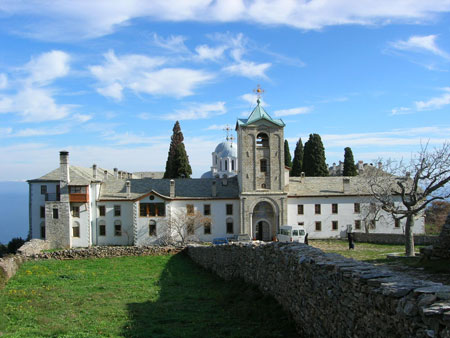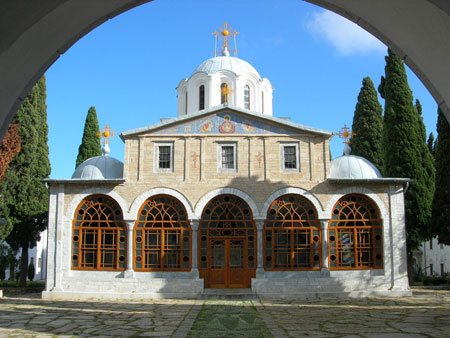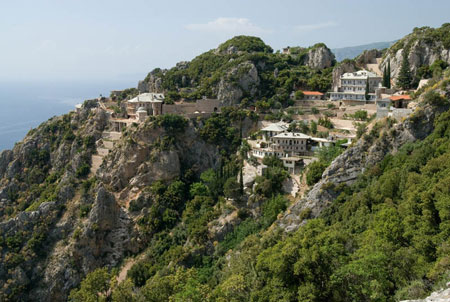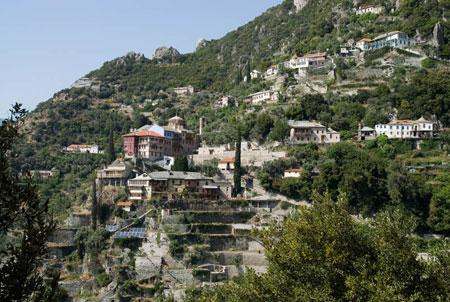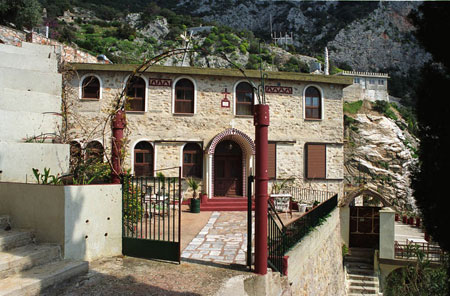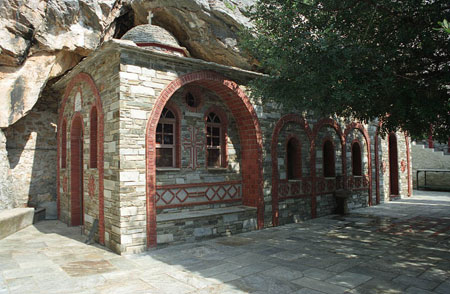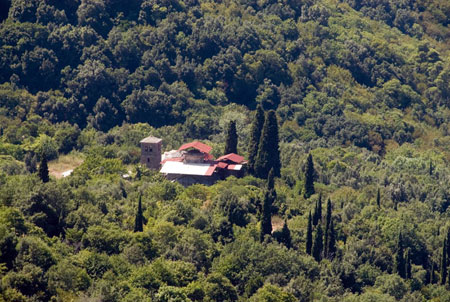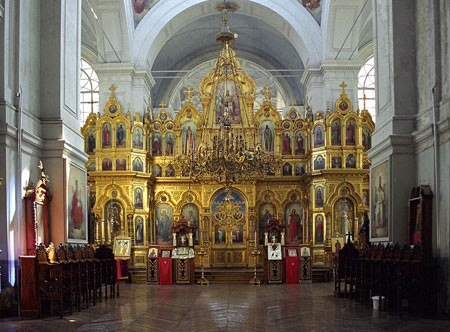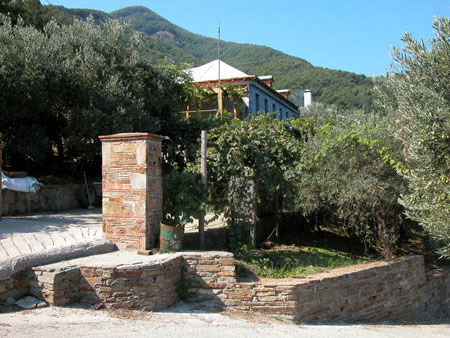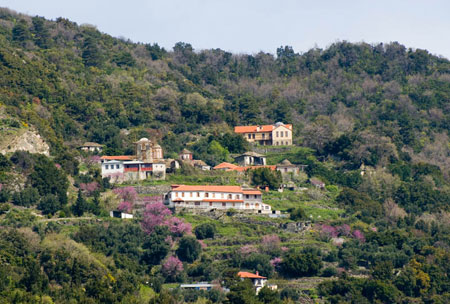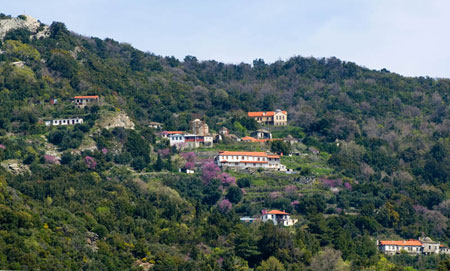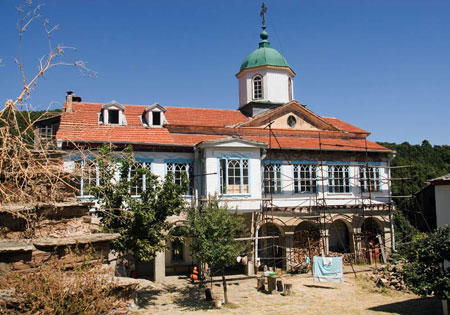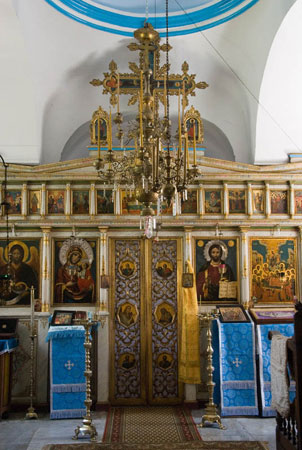The sketae - Mount Athos
The sketae appeared in the nineteenth century. They were founded on the basis of contracts signed by the representatives of the monasteries and ratified by the Oecumenical Patriarchate, on land owned by the monasteries. Today there are twelve sketae all over the Athos Peninsula. The sketae, like the monasteries, are divided into coenobitic and idiorrhythmic. Their inhabitants are occupied in farming and handicraft making. Life in sketae is harsh since monks depend more on their own work and production.
The coenobitic sketae closely resemble the monasteries, being surrounded by cells, with a large church in the center. They are administered by a hegumen, who is called the dikaios, and representatives are appointed annually to perform executive functions.
The idiorrhythmic sketae are like little villages. The cells here are called kalyvae (’huts’) and are essentially tiny houses with one or two rooms, a chapel, and adjacent structures. The common church, the Kyriakon, stands in the middle of the ’village’, and is used on Sundays and feast days. The idiorrhythmic sketae are administered by a dikaios, who is elected by the older monks (gerontes or elders) and assisted by four of these.
All sketae are owned by monasteries. The associations between sketae and monasteries are shown in the following table:
The Skete of Saint John the Baptist (Romanian)
The Romanian skete of Saint John the Baptist belongs to the Holy Monastery of Great Lavra. It lies between Kavsokalyvia and Great Lavra, in a rocky and low hill. Until the mid 19th century it was a Greek Kellion. In 1857 it was sold to two Romanian monks, Nectarios and Niphon. After this it was recognized as a skete.
It is inhabited by 25 monks of Romanian origin and follows the coenobitic principle of monastic life.
The skete follows the architectural style of the Athonian monasteries, i.e. its buildings form a rectangle surrounding a court. In the center of the court there is the katholikon (central church), of Athonian style, which is dedicated to the Baptism of Christ.
The Kyriakon was built in 1866 and it is dedicated to Saint John the Baptist. Within this church lies the miraculous icon of the Mother of God which according to legend was not made by the hand of man. One can also find here the remains of many saints.
In its library there are 130 manuscripts and 5000 printed books, most of them in the Romanian language.
The Skete of Saint Anne, Major
The skete of Saint Anne belongs to the Holy Monastery of the Great Lavra. It is the largest and oldest skete of Mount Athos. It is located at an altitude of 340 m in a rugged but fertile region close to the Athos cape. It was founded the last decades of the 17th century in order to preserve the left foot of St Anne, the Mother of the Virgin, brought to this region by monks in 1686.
It is a Greek idiorrhythmic skete, consisting of fifty one kalyvae inhabited by 85 monks. Some are occupied with fishing and gardening, wherease others practice hagiography, wood carving, the production of incense and miniature art. The Kyriakon was built in 1754, frescoed the same time and it is dedicated to Saint Anne. The temple hosts the relics of several saintly martyrs of the Church.
The Skete of Saint Anne, Minor
Between the Major Skete of Saint Anne and Karoulia, on a steep and rocky mountain side, the Minor Skete of Saint Anne was founded by a few monks who settled here during the 17th century. It consists of seven Kalyvae. The monks are occupied with hagiography, miniature art and wood carving. Important houses of hagiography are those of the monks Ananias and Kartsonas.
Close to the skete there is the cave in which the saintlies Dionisius the Orator and Metrophanes, the first hermits in the area, lived.
The Skete of Saint Demetrios (Greek)
The skete of Saint Demetrios belongs to the Holy Monastery of Vatopedi. It is located in the mountains, and is at a half hour’s walking distance from the monastery. It has been operating as a skete since the 18th century.
It is a Greek idiorrhythmic skete, resemebling a settlement and it consists of 21 kalyvae, most of which are in ruins. The Kyriakon is dedicated to Saint Demetrios. It was built in the 12th century; it was renovated and later expanded and was frescoed in 1755.
The Skete of Saint Andrew
Very close to Karyes, on the road that connects Karyes with Daphne, one finds the Russian Skete of Saint Andrew, which belongs to the Monastery of Vatopedi. It is a huge building complex that follows the architectural paradigm of the Athonian monasteries, i.e. it is surrounded by tall buildings overlooking an internal court. In the center of the court stands the main church.
It is called a skete because according to the customs and the statute of Mount Athos it is not possible to found new monasteries, besides the one of the Byzantine era. It was built with the financial sponsorship of the Russian Czars and many Russian monks practiced ascetic life here. Indeed, just before World War I, the skete was inhabited by approximately 700 monks. Nowadays five Greek monks reside here and have taken upon them to revive the skete and deal with the preservation of the icons and the maintenance of the premises.
The central church of the skete is dedicated to Saint Andrew. It was built in 1867 according to the athonian monasteries’ style. It is the largest church on Athos rising to 30 m in height and extending to 60 in length. Golden crosses extend from its cupolas. In the interior of the church the relics of Saint Andrew are kept.
One can also find in the skete the Athonias Academy, a secondary school for aspiring monks.
The Skete of Saint John the Baptist (Greek)
The Greek skete of Saint John the Baptist belongs to the Holy Monastery of Iveron, an hour’s walk from the monastery to the west. The skete was founded in 1730 by Greek monks.
It is a Greek idiorrhythmic skete consisting of eight kalyvae. All except one, which is inhabited by six monks occupied with the production of incense, lay in ruins. The Kyriakon was built in 1779, it was frescoed in 1799 and is dedicated to the Beheading of John the Baptist. The skete also has a guest house and a refectory.
The Skete of Saint Panteleimon
The skete of Saint Panteleimon belongs to the Holy Monastery of Koutloumousiou, from which it is almost a half hour’s walk away. It was founded in 1785 by the priest-monk Charalambos, on dry and arid land, at the site of an older Kellion.
Today the skete is a Greek idiorrhythmic, consisting of 23 kalyvae arranged as a settlement. The kalyvae are inhabited by twenty monks who are occupied with farming and the products of handiworks.
The Kyriakon was built in 1790 and is dedicated to Saint Panteleimon. It was partly frescoed in 1868. Next to the Kyriakon there is a three story bell tower, a refectory and an archontariki (guest house).
The Skete of Prophet Elijah
The ceonobitic skete of Prophet Elijah is inhabited by 12 Greek monks from the Monastery of Pantokrator. Before the skete was built, within the vicinity of the monastery there were some cells of hesychast monks. In 1757 the Ukrainian monk Paisij Welitschowskij with many Moldavian and Ukrainian monks settled here and produced a remarkable body of spiritual work. The cells eventually evolved into the Russian skete of Prophet Elijah in 1839. Until 1903 the skete, with the support and the unrestrained financing by the Russian czars, developed at a accelerated rate, acquiring an extensive building complex and a huge, impressive church.
The katholikon (central church) was inaugurated in 1903. It is dedicated to the Prophet Elijah, Saint Alexandra and the Apostle Andrew. Its internal decoration is rich, however the church ihas no frescoes. There are also three chapels in the skete: Saint Metropahnes and the Saints Theopatores; the Saint Nicholas, bishop of Myra; and the Annunciation.
The skete is also home the miraculous icon of the the Weaping Mother of God and the Lactating Mother of God as well as invaluable objects of worship. The skete also has quite a rich library.
The Skete of St. Demetrios or Lakkoskete (Romanian)
This is a Romanian skete located one and a half hour’s walking distance from the Holy Monastery of Saint Paul, where it belongs. It is built at an altitude of 280 m between Marphonou and Antiathon. It was founded in 10th century by monks from Moldova. Today it consists of twenty five kalyvae and it is inhabited by Romanian monks.
The Kyriakon was built bettween the years 1898 and 1899 and is dedicated to the Holy Martyr Demetrios. Closeby one find the refectory and the archontariki (guest house).
The Skete of New Skete
The New Skete belongs to the Holy Monastery of Saint Paul. It lies near the sea, between the monastery of Saint Paul and the skete of Saint Anne. It was founded in 18th century. Within the vicinity of the skete many graves, coins and other artifacts have been found. These findings support the hypothesis that during ancient times one of the cities of Athos was located here.
Today the New Skete is Greek and follows the idiorrhythmic way of monastic life. It consists of twenty eight kalyvae inhabited by 40 monks who are occupied wuth hagiography, wood carving and farming.
The Kyriakon was built in 1760 and is dedicated to the Nativity of the Mother of God. The library of the skete is home to 200 manuscripts and 500 old printed books.
The Skete of Annunciation of the Mother of God
The Greek skete of Annunciation belongs to the Holy Monastery of Xenophontos. It was founded in 1766 by the priest-monk Sylvester and the monks Ephraim and Agapios.
Today there are twenty two kalyvae inhabited by ten Greek monks occupied by farming and the production of incense. It follows the idiorrhythmic way of monastic life. The Kyriakon was built in 1766 and it was frescoed the same time. It is dedicated to the Annunciation of the Mother of God. The skete is the final resting place of the relics of many saints, whereas its library holds 360 manuscript volumes.
The Skete of Bogoroditsa
The skete Bogoroditsa belongs to the Holy Monastery of Saint Panteleimon. It is situated in a forested area, between the monasteries of Vatopedi and Pantokrator. It lies on the site of the preexisting monastery of Xylourgos.
It is inhabited by Bulgarian monks and it follows the coenobitic way of monastic life. The Kyriakon is dedicated to the Assumption of the Mother of God.
The Skete of Kavsokalivia
